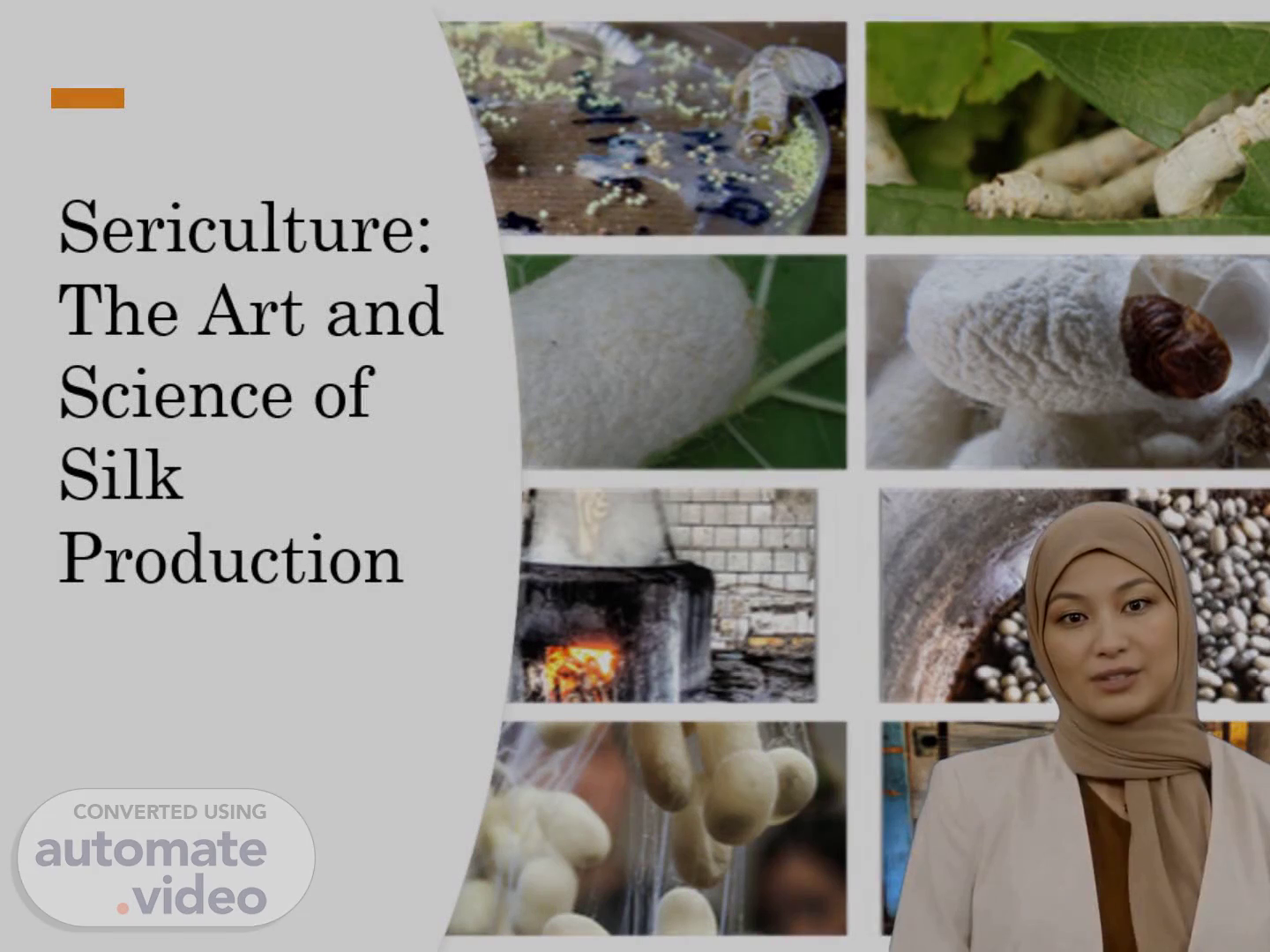Scene 1 (0s)
[Virtual Presenter] Sericulture is a field where art meets science, as we delve into the fascinating world of silk production, tracing its roots from ancient times to modern practices. We will explore the intricacies of sericulture and uncover its importance in our daily lives..
Scene 2 (16s)
[Audio] Students will be able to understand sericulture fundamentals, analyze challenges and solutions, and evaluate impacts and opportunities. This comprehensive understanding will enable them to grasp the intricacies of this multifaceted industry, from its historical roots to its modern-day applications. By mastering these skills, students will be equipped to tackle complex problems, think critically, and develop innovative solutions..
Scene 3 (44s)
[Audio] Silk production has been an integral part of human civilization for thousands of years. From ancient China to modern-day India, sericulture has played a significant role in shaping cultures, economies, and societies. The art of silk production involves a delicate process of cultivating silkworms, harvesting their cocoons, and unwinding the silk filament from the cocoon. This labor-intensive process requires great skill, patience, and attention to detail..
Scene 4 (1m 45s)
[Audio] The life cycle of the silkworm begins with the egg stage, laid by the female moth. This is followed by the larval stage, where the caterpillar feeds on mulberry leaves. As it grows, the caterpillar spins a silk cocoon around itself, entering the pupal stage. Finally, the adult moth emerges from the cocoon, ready to start the reproductive process again..
Scene 5 (2m 5s)
[Audio] Sericulture relies heavily on the cultivation of high-quality mulberry leaves, which serve as the primary food source for silkworms. The quality of these leaves has a direct impact on the final product, making it essential to ensure optimal growing conditions and proper care for the mulberry trees. This process, known as moriculture, plays a crucial role in sericulture, as it provides the foundation for successful silkworm rearing and ultimately, the production of high-quality silk..
Scene 8 (3m 44s)
[Audio] The silk industry in Pakistan has faced numerous challenges over the years. A significant problem is the decline in mulberry leaf production, primarily due to the scarcity of suitable land and climate conditions for cultivation. Limited skilled labor and technical expertise within the industry are additional hurdles. Moreover, the industry competes with imported silk products, which can be cheaper than domestically produced ones. To address these issues, investing in research and development to enhance mulberry leaf quality and quantity is crucial, along with providing training and capacity-building programs for farmers and workers. Furthermore, government support and incentives can promote local silk production and reduce reliance on imports..
Scene 9 (4m 28s)
[Audio] The challenges faced by Pakistan's silk industry include outdated farming techniques, lack of modern equipment, and shortage of quality mulberry trees. These limitations hinder the production of high-quality silk, making it difficult for farmers to compete in the global market. To address these issues, the government has initiated various programs, including training sessions for farmers, mulberry plantation drives, research and development projects, and establishment of sericulture farms. These initiatives aim to improve the efficiency and productivity of the silk industry, ultimately enhancing its competitiveness and sustainability..
Scene 10 (5m 7s)
[Audio] Silk production has significant economic impacts on various sectors. It generates revenue through the sale of silk products, creating employment opportunities and stimulating local economies. However, it also leads to the depletion of natural resources, such as water and land, and contributes to greenhouse gas emissions. The cultivation of mulberry bushes, a crucial step in sericulture, can lead to soil degradation and erosion. The environmental impact of sericulture is another pressing concern. The use of pesticides and fertilizers in mulberry cultivation can contaminate soil and water, posing risks to human health and the ecosystem. Moreover, the disposal of silk waste and by-products can contribute to pollution and waste management issues. Despite these challenges, sericulture holds promising prospects. With advancements in technology and sustainable practices, the industry can reduce its ecological footprint while maintaining its economic viability. Additionally, research into alternative silk sources and innovative production methods can help mitigate the negative impacts of traditional sericulture..
Scene 11 (6m 11s)
[Audio] Sericulture is a multifaceted industry that has far-reaching implications beyond its immediate economic benefits. It is not only a source of income for many communities but also plays a significant role in preserving our cultural heritage and promoting sustainable development. As we conclude this presentation, I would like to emphasize the importance of supporting and investing in Pakistan's silk industry. With the right resources and infrastructure, this industry can thrive and contribute significantly to the country's economy..
